|

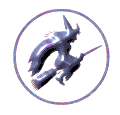

The
Gods & Goddesses
(Greek Mythology)

Compiled
by George Knowles
Overview
The
legends of ancient Greece are quite familiar to most people as down through the
ages they have become mixed and embedded in the literary traditions of many
other cultures. Greek mythology
follows the pattern of other mythologies in that the forces of nature were given
personalities and then worshiped. Greek
gods and goddesses were seen as being much like men and women.
The term for this is 'anthropomorphism', meaning "in the form of a
human". The gods were
conceived as more heroic in stature, more outstanding in beauty and proportion,
and more powerful and enduring than humans.
Humans could die, but the gods lived on. They were nevertheless endowed with many human weaknesses.
They could be jealous, envious, spiteful and petty.
Among them only Zeus was known as “Just”. The Greeks believed that their gods lived on Mount Olympus
where they dwelt together in a community of light and pleasantness, and
from this height they mingled with and often interfered with the lives of
humans.
Before
the Olympian God's there had been the
Titans: Gaea was their mother
and Goddess of the Earth, while Uranus was their father and God of
the Heavens. According to Hesiod
(an 8th century Greek poet and writer whose 'Theogony' relates to the myths of
the gods), Gaea and Uranus had 12 sons and daughters who made up the original
Titans. The brothers were called:
Oceanus, Coeus, Crius, Hyperion, Iapetus and Cronus, and the sisters were
called:
Thea, Rhea, Themis, Mnemosyne, Phoebe and Tethys.
Uranus was a tyrannical god and
feared some day that one of his children would try to overthrow him, he
therefore
shut them off in the underworld of Tartarus (the infernal abyss below Hades, a
place of punishment for the wicked after death). However under the leadership of
his youngest son Cronus, the Titans rebelled against their father and during the
ensuing battle dethroned and castrated him. His
severed genitals were thrown into the sea, which caused the sea to foam, and
from this bloody foam Aphrodite the goddess of sexual love was born. While Uranus lay mortally wounded his blood also soaked
into the earth from which emerged the three Erinyes (the Furies - Megaera,
the jealous one, Alecto, unceasing in anger and Tisiphone, the avenger of murder).
Having
deposed of his father, Cronus then became ruler of the Titans. married his sister Rhea
with whom he would produce six children, three daughters and three sons. However, like his father before him, Cronus
feared one of his own sons would try to overthrow him. So as Rhea
gave birth to each, first Hestia, then Demeter, Hera, Poseidon
and Hades, Cronus eat and swallowed them whole. Rhea fearing the same fate
for her sixth child Zeus, tricked Cronus and gave him a stone wrapped in
swaddling clothes to swallow, and
concealed the new born Zeus in Crete where he wouldn't be found. Guarded
and raised
by nymphs, he was fed on the milk of the goat Amalthaea. Zeus soon grew
big and strong and once matured, forced his father Cronus to disgorge his
brothers and sisters, who in turn were eager to exact vengeance on their
father. In the war that followed, the Titans fought on the side of Cronus,
but Zeus and the other gods were successful, and the Titans were consigned to
the abyss of Tartarus. Zeus henceforth ruled over the sky, and his
brothers Poseidon and Hades were given power over the sea and the underworld,
respectively. The earth was to be ruled in common by all three.
Apollo
another son of Zeus drove the chariot of the sun across the skies.
He was also a music maker, the god of light and song, and worshiped by
poets (see Apollo). Hermes
another son was the messenger of the gods, and Hephaestus was the god of fire.
Hephaestus was the only one of the gods who was not beautiful, but he was
skilled in craftsmanship and forged the armor of the gods, thus he became known
as the patron of handicrafts and the protector of blacksmiths.
Then there was Artemis the twin sister of Apollo and goddess of the moon.
Artemis was a favorite among rural people as the goddess of vegetation,
she was attended by nymphs (naiads) as she supervised water and the lush wild
growth of nature. She was also the goddess of wild
animals and the hunt, and is often depicted with a stag or a hunting dog.
Demeter
the other sister of Zeus was the goddess of grain and the harvest. Her legend is
centered on the story of her daughter Persephone, who was stolen by Hades and
taken to live in the underworld. Demeter
heard her daughter's cries but no one knew where she had been taken.
Because Demeter was distressed by Persephone's disappearance, she lost
interest in the harvest, as a result there was widespread famine.
When Apollo travelling under the Earth as he did over it, saw Persephone
in the underworld he told Zeus. Zeus
then sent Hermes to bring Persephone back and Hades knew he must obey, but because
Persephone had eaten the seed of a pomegranate while in the land of the dead,
she had to return there for four months of every year.
Each year when her daughter returned from the land of the dead, Demeter
made the Earth bloom and bear fruit again.
Through this story the Greeks interpreted the miracle of the revolving
seasons, spring came when Persephone returned after her winter in the
underworld, leading into summer, and her return in to Hades in the autumn led us
back to winter.
These
were the 12 major gods, but there were other lesser gods whom the Greeks
worshiped. Dionysus for instance was
the god of wine. He was a
nature god of fruitfulness and vegetation.
Lavish festivals called Dionysia were held in his honor.
He came to represent the irrational side of human nature, while Apollo
represented order and reason. The
attendants of Dionysus were the satyrs, minor gods representing the forces of
nature. They were depicted with
bodies of animals and had small horns and tails like a goat's.
Similar in appearance to the satyrs was Pan, a god who did not live on
Mount Olympus; instead he guarded the flocks while playing his pipes.
The
Muses, from whose name the word music is derived, were nine goddesses who came
to be regarded as patrons of the arts and sciences.
Their names and the endeavors they inspired were:
Clio – history, Calliope - epic poetry, Erato - love poetry, Euterpe -
lyric poetry, Melpomene – tragedy, Polyhymnia - song, rhetoric and geometry,
Thalia – comedy, Terpsichore - dancing and Urania - astronomy and astrology.
Perhaps
the most threatening of the goddesses were the Fates, called collectively Moirai.
There were three Fates, whom Homer (another 8th century Greek
poet whose epic writings
the “Iliad” and the “Odyssey” profoundly
influenced ancient Greek culture and the subsequent development of Western
literature)
called
the "spinners of the thread of life".
Clotho was the spinner of the thread and was also a birth goddess
representing the future. Lachesis
measured the length of the thread and the amount of time allotted to each person
on earth, thus representing the present. Atropos
who cut the thread was inflexible and represented the
past. Between them the Fates had
more power than most other gods and whoever resisted them had to face Nemesis,
the goddess of justice.
Hypnos
was the god of sleep and brother of Thanatos (Death). The son of Hypnos was Morpheus the god of dreams.
Thanatos was not worshiped as a god and Homer refers to him as a son of
Nyx (Night), while Hesiod declared that the gods hated him because he was the
personification of death.
End


Zeus
Zeus is considered to be one of the
greatest gods in Greek mythology, in Roman mythology he is known as Jupiter.
Zeus was the father of gods and men, protector of kings, supporter of law
and order and avenger of broken oaths and other offenses.
He watched over the state, the family and strangers, his hand wielded
lightning and guided the stars, he gathered rain clouds, he ordained the changes
of the seasons and regulated the whole course of nature, and with his other gods
on Mount Olympus, Zeus ruled over the affairs of mankind.
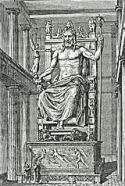
Zeus - Ruler of the
Greek Gods
According to legend after
a ten-year struggle on Mount
Olympus, Zeus overthrows
his father Cronus
and expelled him and the rest of the older dynasty of
the Titans back to Tartarus (the infernal abyss below Hades).
He also withstood the attacks of the giants and the conspiracies of the
other gods. Zeus divided up the
universe between his remaining family of gods, allotting himself the empire of
the heaven and air. His brother
Hades (called Pluto by the Romans) was given that of the infernal regions, and
Poseidon (Neptune) that of the sea. The
Earth he left under the joint rule of the three.
The wife of Zeus was Hera (Juno), queen
of the gods. Their union was
regarded as the divine prototype of all earthly marriages, even though Zeus was
not always faithful to Hera. Some
authorities explain his indiscretions by saying that many adventures of the
other gods were ascribed to Zeus.
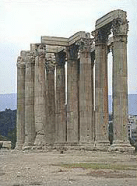
Ancient
temple of Zeus in Athens
The 4th of the then Seven Wonders of the
ancient world was said to have been a statue of Zeus by Phidias which was placed
in the great temple of Zeus at Olympia. The
figure stood about 40 feet (12 meters) high and was made of ivory and gold in
about 430 BC.
The design is known from its image stamped on certain Greek coins.
End


Poseidon
The son of Cronus and Rhea, Poseidon is
most famous as the God of the Sea. His brothers and sisters include: Zeus, Hades, Hestia, Demeter and Hera. After the division of the world, Zeus ruled the Sky, Poseidon
the Sea and Hades the Underworld. Poseidon
was also known as the God of Earthquakes and the God of Horses.
The symbols associated with Poseidon are dolphins and tridents.
Sailors relied on Poseidon for a safe voyage on the sea and many drowned
horses in sacrifice of his honor. He
lived on the ocean floor in a palace made of coral and gems, and drove a chariot
pulled by horses. Poseidon was very
moody and his temper could sometimes result in violence.
When he was in a good mood, he would calm the sea and create new lands in
the water, but in a bad mood, he would strike the ground with his trident and
cause unruly springs and earthquakes to erupt sinking ships and drowning
sailors.
Poseidon was similar to his brother Zeus
when exerting his power over women. He
had many love affairs and fathered numerous children. One tale tells how he once married a Nereid called Amphitrite,
and by her produced a Triton who was half-human and half-fish.
He also had an affair with the Gorgon Medusa from which she conceived
Chrysaor and Pegasus the flying horse. The
rape of Aethra resulted in the birth of Theseus; and after the rape he turned
Caeneus into a man at her request. Another
rape involved Amymone, after she tried to escape from a satyr and he saved her.
Other children sired by Poseidon include: Eumolpus the Giant Sinis, Polyphemus, Orion, King Amycus,
Proteus, Agenor and Belus from Europa, Pelias and the King of Egypt Busiris.
One of the most notorious love affairs
of Poseidon involves his sister Demeter. As
he continued to pursue her, Demeter disguised herself as a mare to avoid him,
but Poseidon responded by transforming himself into a stallion and cornered her,
their mating resulted in the horse Arion. Another
story involves Poseidon and Athena the Goddess of War in a competition to
control the seaport city of Athens. To
win the people of the city over, Poseidon threw a spear at the ground and
produced the Spring at the Acropolis. Athena
won as the result of giving the people of Athens the olive tree and in his anger
over the decision, Poseidon flooded the Attic Plain.
Eventually however, Athena and Poseidon worked together by combining
their powers. Even though Poseidon
was the God of Horses, Athena built the first chariot; she also built the first
ship to sail on the sea over which Poseidon ruled.
Poseidon often used his powers of
earthquakes, water and horses to inflict fear and punishment on people as
revenge, and though he could be difficult, he could also be cooperative; it was
Poseidon who helped the Greeks during the Trojan War.
End


Hades
and Hell
Hades
In Greek
mythology Hades is the King of the Dead. He
is a son of the titans Cronus and Rhea, and brother to Zeus, Poseidon,
Demeter, Hera and Hestia After
Zeus had overthrown Cronus, the three brothers divided the world between them.
Zeus ruled the heavens; Poseidon ruled the sea and Hades was left
to rule the underworld. There, with
his queen Persephone, who he abducted from the world above, he ruled the kingdom
of the dead.
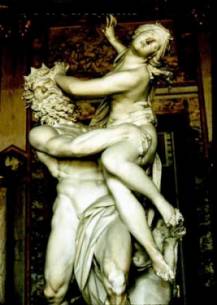
Hades
abducts Persephone
Although Hades
was a grim and pitiless god, unappeased by prayer or sacrifice, he was not an
evil god; mostly he was concerned with increasing the number of his subjects,
which he ruled justly. Those whose
calling increased the number of his dead subjects were seen as welcome guests,
the Erinnyes (the Furies) for example were particularly welcome.
Once in his realm, he was disinclined to allow any of his subjects leave,
a condition that even applied to his wife Persephone, who he allowed to visit
with her mother Demeter during the Spring and Summer, provided she return to him
in the Winter. One exception was the legend of Orpheus and Eurydice.
Hades may have
been a remorseless god with a terrible temper, but he was not capricious.
Indeed as Pluto (his Roman aspect) he was also known as the god of wealth
and riches, because as crops were grown and precious metals mined from the
earth, people believed them to have come from his kingdom below the ground.
He also had a helmet that made the wearer invisible, given to him by the
Cyclopes in appreciation of his help and prowess in battle, this he would lend
to other gods and mortals when needed (as in the legend of Perseus).
Of all the
Olympian gods, Hades is the one least liked, and except for Zeus, most other
gods lived in fear and had an aversion of him.
He was a frightening opponent in battle and had proved his worth during the ten-year war of Titanomachy,
the battle of the Olympians versus the Titans in which Zeus had overthrown his
father Cronus. His weapon of choice
was a two-pronged fork, which he used to shatter anything in his way or not to
his liking (much as Poseidon did with his trident). Hades rode into battle on a dark chariot drawn by four huge
coal-black horses, an impressive sight striking fear into the hearts of his
enemies. Although he was an
Olympian, Hades spent most of the time in his own dark realm.
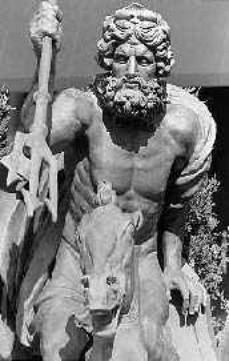
Hades
rides into battle
In the real
world, people avoided speaking his name lest they attracted his unwanted
attention. In rituals they
sacrificed black sheep, letting the blood of the sacrifice drip and seep into
the earth, at the same time while praying to him, they would bang their hands on
the ground so he would hear their devotions.
Sacred to him was the narcissus plant (named after Narcissus, who in
Greek mythology was a beautiful young man who had rejected the love of the nymph
Echo, and was condemned to fall in love with his own reflection in a pool.
So intense was his passion for himself he pined away, and in the place
where he died a flower sprang up that was named after him), the species of which
genus includes: daffodils, jonquils
and narcissuses. The cypress is
also sacred to him; branches of cypress were used as a symbol of mourning.
Hell
The underworld is
often referred to as Hell, or ‘Hades’ in reference to his title as King of
the dead. Hell was his place of
residence, a place divided into two regions: Erebus, where the dead pass on to as soon as they die, and
Tartarus a deeper region, the infernal abyss, a place of punishment for the
wicked after death and where the Titans had been imprisoned.
Hell the underworld of Hades was a dark, dim, subterranean place,
inhabited by vague forms, shadows and numerous rivers.
Somewhere in the
darkness of the underworld was the palace of Hades. It is often depicted as a many-gated, dark and gloomy place,
set in the midst of shadowy fields and haunted landscapes.
Cerberus a fierce three-headed, dragon-tailed dog, guards the gates.
Inside however, it was redolent with the treasures of the earth and
thronged with his guests. From here
Hades ruled his kingdom while sitting on a throne made of ebony, the scepter and badge of his office
was a staff, with which he drove unrepentant souls of the dead into the lower
world of Tartarus. To get to the palace was a long and
perilous journey crossing the many rivers.
On death, the soul of a person was lead by Hermes to the entrance of the
underworld, there to be met by the aged Charon who runs the only ferry allowed
the cross the rivers. Only those
who could pay the fare (after death, coins and other treasures were often buried
with the deceased for this purpose) would receive passage, those who couldn’t
pay would be trapped between two worlds. The
journey would begin on the Acheron (the river of woe), down the Cocytus (the
river of lamentation), into the Lethe (the river of forgetfulness), through the
Phlegethon (the river of fire) and on to the Styx (the
river of hate) to arrive at the gates of the palace.
The soul then enters through the gates to be met by Cerberus, who allows
all souls to enter, but none to leave. The
soul then appears before a panel of three judges, Rhadamanthus, Minos, and
Aeacus, who review the souls past life. Those who had been good were blessed and allowed to proceed
into the Elysian Fields, a happy final resting place. Those who had not were damned and abolished to Tartarus,
the infernal abyss, there to forever reside in torment.
The legends of Sisyphus
and Tantalus are examples of this.
End


Athena
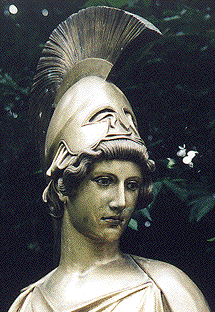
Athena
(also known as Pallas Athena or simply as Pallas) is the Greek goddess of wisdom
and war. The Romans identified her
as Minerva and ranked her third among their gods after Jupiter and Juno.
Athena was worshiped as the goddess of crafts especially those of
spinning, weaving and needlework, she is also credited with inventing
earthenware. Later she was
associated with agriculture and navigation.
Her cult animal was the owl, and a series of terracotta plaques still
exist from ancient Greece depicting an owl with human arms spinning wool.
In
mythology Athena was the favorite daughter of Zeus (Jupiter), and was said to
have sprung from his head, fully grown and clothed in armor.
She is often depicted wearing a helmet and carrying a spear and shield.
Like her father she also wore a magical “aegis”, a goatskin
breastplate fringed with snakes that produced thunderbolts when shaken.
As a goddess of war she represented the intellectual side of war, that of
defense rather than aggression, for she was not so much a fighter more a wise
and prudent adviser.
Athena
was regarded as the protector of all cities and states.
She was wise not only in war but also in the arts of peace.
In her association with agriculture, she is credited with the invention
of the plow and taught men how to yoke oxen.
Her main place of worship was the seaport city of Athens, but as a
seaport Poseidon (Neptune) also laid claim on the city.
Zeus as the ruler of the gods stepped in and decreed that the city should
be given to the god who offered the most useful gift to aid mankind, and called
for a counsel of the gods to decide the outcome.
Poseidon created a horse from the sea and explained to the gods that the
horse would aid mankind in their labours. Athena
struck the bare soil with her spear and created an olive tree, informing the
gods that the tree would provide food for all mankind and oil for their lamps,
with which their could light the temples and give worship to the gods.
The gods were so impressed with her creation they declared her the
winner, so Zeus gave the city to Athena and named it after her.
In iconology Athena is often shown with an olive branch as symbol of
peace and plenty.
On the
hill of the Acropolis the Athenians built a beautiful temple to Athena called
the Parthenon (from “parthenos” meaning "virgin").
In the temple stood an ivory and gold statue called “Athena Parthenos”,
Phidias the Greeks greatest sculptor sculpted it.
The Athenians held their most important festival called the
“Panathenaea” on the day thought to be Athena’s birthday.
It was celebrated by a procession followed by sacrifices and games.
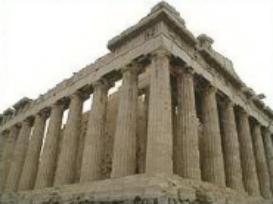
(Parthenon
the temple to Athena)
In her
guise as Minerva, another myth evolved in which a mortal woman named
“Arachne” challenges her to a contest of spinning and weaving. During the contest Arachne wove images of the gods being
deceived by other gods, and more images of them failing in their endeavours as
gods. Minerva was so insulted by
these images that she decided to punish Arachne for her impiety, and transformed
her into a spider.
End


Apollo
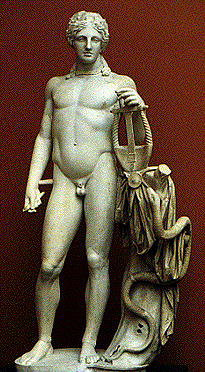
Of the 12 great gods of Greece the
handsomest and best loved was Apollo. He
was the god of light, youth, beauty and prophecy.
The son of Zeus and twin brother of Artemis (Diana), he was born on the
island of Delos in the Aegean Sea. His
mother was the goddess Leto (Latona). Apollo
became identified with Helios as a god of the sun, through which the Greeks
connected him with agriculture calling him the:
“Protector of the Grain, Sender of fertilizing Dew, Preventer of
blight, Destroyer of Locusts and Destroyer of Mice”.
They also considered him to be the guardian of flocks and herds, and a
health-giving god. He was hailed as
the "god of the silver bow" and in wartime as "the helper".
According to legend in one of his
earliest deeds, Apollo slayed the deadly serpent Python. It lived in a cave on Mount Parnassus and so terrified the
peoples of Delphi that no mere man dared to approach it.
When the people asked Apollo to save them, he came down from Mount
Olympus with his silver bow and a quiver of golden arrows but needed only one
arrow to kill the serpent. To commemorate this victory Apollo started the Pythian games,
which were held every four years in ancient Greece. Winners in feats of strength, foot races and in chariot races
were crowned with wreaths of laurel leaves.
Apollo was also the god of song, music
and poetry. He charmed the gods
with his playing at the banquets held in their palaces on Mount Olympus.
It was said among the later Greeks that he invented both the flute and
the lyre.
At Delphi in central Greece near the
foot of Mount Parnassus in a place sacred to both Apollo and the Muses, was the
famous oracle of Apollo. Here his
priestess made known the future to all who consulted her.
She gave guidance in matters of sickness, war and peace and in the
building of new colonies. The tripod was dedicated especially to Apollo and it was
sacred to him as the god of prophecy. He
was made one of the chief gods of Rome by an edict of the Emperor Augustus. The
emperor regarded him as his patron deity and built a magnificent temple in his
honor.
Ancient sculptors and painters depicted
Apollo as a beautiful youth with flowing long hair tied in a knot above his
forehead, crowned with a wreath of laurel and bearing his lyre or bow.
The most famous statue of him is the “Apollo Belvedere”, which is a
Roman copy of a bronze Greek original and now stands in the Vatican Museum in
Rome.
End


Artemis
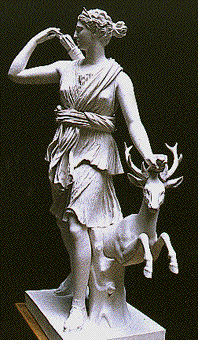
Artemis
is the daughter of Zeus and Leto and the twin sister of Apollo.
She is a nature goddess but also a goddess of the hunt and wild animals,
she is often depicted with a stag or a hunting dog.
She was the huntress of the gods and the protector of the young, and like
her brother Apollo she hunted with silver arrows.
Artemis was a virgin goddess and a goddess of chastity, but later in her
guise as the Roman goddess “Diana”, she was not so chaste.
As Artemis, she presided over childbirth, which may seem at odds with her
being a virgin but the association goes back to her birth, for while she herself
had been born pain free, her brother Apollo caused Leto great suffering.
No sooner had she been born then Artemis served as midwife for the birth
of Apollo and so became known as the protector and helper of women.
Throughout the ages women have traditionally preyed to her to ease the
hardship of childbirth.
As a youth she had a boyish sense of
adventure and was fiercely independent. She
requested and was granted from her father a bow and quiver of arrows similar to
that of her brother Apollo, but Zeus, the concerned father, also gave her a band
of nymph maidens and a pack of hounds to follow her.
To aid her running and to ensure her chastity, he also gave her a short
tunic so she could run forever through the wilderness.
She came to protect all wildlife and animals, and any humans who asked
for her aid, particular women who had been raped or victimized by men, in which
cases she was quick to punish offenders.
Her punishment of men is recorded in
legend. Actaecon, a hunter who
spied on Artemis and her nymphs as they bathed nude in a forest pool, was turned
into a stag and torn to pieces by his own hounds.
In another legend she sent a boar to ravage the countryside of Calydon as
punishment to King Oeneus because he forgot to pay tribute to her in the first
sacrifice of the fruits of the harvest. He
sent out some of his bravest warriors in Greece but none could slay the beast,
it took another woman “Atalanta” to kill it.
Her most famous legend concerns the
death of Orion, who she killed with an arrow through the head.
Orion was a great and handsome hunter who won the affections of Artemis,
but her brother Apollo didn’t like him and accused him of distracting her from
her duties. Apollo then tricked Artemis into shooting him with the arrow.
When she discovered the trick the grieving Artemis honored Orion in the
sky, after whom the star constellation "Orion the Hunter " was named.
In another version, Artemis killed him because of his arrogance and out
of jealousy over his feelings for Dawn.
The worship of Artemis was prolific and
flourished throughout the Mediterranean regions as far back as the Bronze Age.
Later Greek colonists at Ephesus in Asia Minor built a famous temple to
her. The early Greek settlers found
the Asian inhabitants worshiping a many-breasted nature goddess who they
identified with their Artemis. So
together they raised a shrine to her, this was rebuilt and enlarged as time
went by. The fourth temple to be
built was known as “The Temple of Artemis”, and became famous as one of the
“Seven Wonders of the then World”. Made
of marble except for its tile-covered wooden roof, it was built by contributions
from all the great cities of Asia. Dedicated
about 430 BC, it had
taken some 120 years to complete.
According to legend it was set on fire and destroyed on the night
Alexander the Great was born in 356 BC. Someone
called Herostratus started the blaze merely so his name might be remembered in
history.
Later as Greece became absorbed into the
Roman Empire, many of the Greek gods were renamed to suit the Roman culture of
gods, and so Artemis became better known as Diana. Diana retained many of the attributes of Artemis, such as
being a virgin goddess and a maiden warrior-goddess of the hunt, but she
differed in that she was not so chaste. It
was rumoured among the gods that she had many lovers such as:
Hippolytus, Endymion, Virbius and Dianus, and by some accounts she even
took her brother Apollo as a lover. Diana
also became associated with the moon. As
a moon goddess she shared a lunar trinity with Selene and Hecate, but
representing power over the earth she became revered as the patroness of
witches. Diana personifies the
positive aspects of the moon, the main source of a witch’s magickal power, as
well as woman’s independence, self-esteem and aggressiveness, she was the
eternal feminist, owned by none and beholden to none.
As a favorite among rural people, Diana was also goddess of vegetation
and attended by her nymphs, she supervised the waters to produce lush wild
growth.
Well into the fifth and sixth centuries
Dianic worship flourished among European pagans, but with the onslaught and
growth of Christianity, Diana became associated with the Devil and Satan.
She was thought to have been the patroness of Sorcery and to have lead
witches processions and evil rites. As
such she also became associated with Herodias, the wife of Herod Antipas, who
was the son of Herod the Great. Herod
Antipas was tetrarch (governor) of Galilee, and it was he who questioned Jesus
before the crucifixion. Earlier he
had divorced his wife and married his niece Herodias, but John the Baptist
denounced his marriage, so Herod had him imprisoned.
Later that year on Herod's birthday, his stepdaughter Salome danced
before him and his guests. Herod
was so delighted he told her she might ask for anything she wished.
At the urging of her mother Herodias, she asked for the head of John the
Baptist. Herod immediately had him
executed, and his head was given to Salome.
After this event Herodias took on
aspects of a demon, and was condemned to wonder through the sky forever, only
allowed to rest in treetops from mid-night till dawn.
In Italian lore the name Herodias became Aradia, who according to Charles
Godfrey Leland was the daughter of Diana and her brother Lucifer.
It was Diana as goddess of the witches, who sent Aradia to earth to teach
the witches their craft.
The Canon Episcopi, an ecclesiastical
law written about circa. 900, also speaks of a devil Diana, one who lead the
witches:
“It
is not to be omitted that some wicked women, perverted by the Devil, seduced by
illusions and phantasms of demons, believe and profess themselves, in the hours
of the night, to ride upon certain beasts with Diana, the goddess of pagans, and
an innumerable multitude of women, and in the silence of the dead of the night
to traverse great spaces of earth, and to obey her commands as of their
mistress, and to be summoned to her service on certain nights”.
British anthropologist Margaret A.
Murray believed that an organized cult of Dianic witches existed throughout the
Middle Ages and the Witch-hunt era, but no other evidence survives to support
these claims. It is thought that
Murray relied heavily upon the above Canon Episcopi in developing her ideas.
Despite this Gerald B. Gardner adopted her theories when he started the
revival of modern day witchcraft in the 1950’s.
In contemporary witchcraft most modern
witches no longer believe in Murray’s Dianic cult theories, though a great
many still revere Diana as a pagan goddess and archetype of women.
In the triple goddess aspects of the moon, Diana holds sway over the new
and waxing moon, a period auspicious for magick related to new beginnings,
growth and achievement, at which time she is also invoked as a nurturer and
protector, particularly of women. At
the full moon she then turns her power over to Selene.
As an archetype she serves as a role model for the feminist tradition of
witchcraft called Dianic Wicca, to many of whom she is a free spirit and
achiever who knows what she wants, and who is neither dependant nor subjugated
by men. Although Diana is a lunar
goddess, she still walks the earth with her bow and arrow, protecting and
defending her domain of the wild. Her
tree is the cypress and all wild animals are scared to her, especially the deer.
End


Dionysus
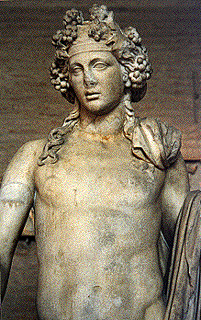
In
Greek mythology Dionysus is the God of Nature, and the
God of the Vine and Wine (later personified by the Roman god Bacchus).
As Dionysus, he was also the God of Ecstasy and his cult was one of the
mystery religions. He produced the
first wine from the vine, and spread the art of tending grapes, but he also had
a dual side to his nature, on the one hand he could bring about joy and divine
ecstasy and on the other hand brutal unthinking rage, both reflecting the nature
of wine.
Dionysus is the son of Zeus and Semele
and the only god to have a mortal parent. Legend has it that Zeus came to Semele in the night invisible, felt only
as a divine presence. Semele was
pleased to be a lover of a god even though she did not know which god it was.
But word of his infidelity soon spread and Hera his wife quickly assumed
who was responsible. She went to
Semele in disguise and convinced her that she should see her lover as he really
was. When Zeus next came to see her, Semele made him promise to
grant her one wish, he was made to swear on the River Styx that he would grant
her request.
Zeus by this time was madly in love and
agreed, even though he knew what would happen.
She then asked him to show her his true form. Zeus was unhappy, but having sworn he had no choice.
When he appeared in his true form Semele was instantly struck dead by the
sight of all his glory. Zeus then took the unborn Dionysus from Semele’ womb and
sewed the infant into his thigh till he was ready to be born.
After due time Dionysus emerged from his thigh perfectly formed and
became known as “the twice-born god” associated with death and rebirth.
In another legend Hera still jealous about
Dionysus arranged for the Titans to kill him, and in
response they ripped him into to pieces. However
the goddess Rhea (also known as Cybele) brought him back to life.
After this Zeus arranged for his protection and turned him over the
mountain nymphs to be raised. It
was they who taught him to tend the vine.
Dionysus is one of the few gods who was able to bring a
dead person out of the underworld. Even
though he had never seen his mother Semele, he descended into the underworld in
an effort to bring her back. Hades
agreed to release her only if Dionysus gave him something he held very dear, so
Dionysus gave up the myrtle plant. On
his way into the underworld he had met a man called Prosymnus from whom he had
asked for directions, the man agreed but asked for certain sexual favors to be
repaid on his return. On his way
out Dionysus was unable to keep his promise to Prosymnus for had died, so
instead Dionysus planted a phallus-shaped stick on his tomb in repayment.
Dionysus wandered the world accompanied by Maenads,
actively encouraging his cult and worship.
The Maenads were wild women often flush with wine, their shoulders draped
with fawn skins and carrying rods tipped with pinecones.
While the other gods erected temples for their worship, the followers of
Dionysus worshipped him in the woods. There
they would work themselves up into mad states of frenzy and ecstasy, and any
animals they came upon would be rip apart in sacrifice, their flesh eaten raw.
As Bacchus he was accompanied Bacchantes, a similar band of woman
worshippers who also roamed the forests dressed in animal skins.
Dionysus became one of the most important gods in everyday
life, and associated with several key concepts. One was rebirth after death.
Here his dismemberment by the Titans and return to life is symbolically
echoed in tending vines. Each year
the vines are pruned back sharply and left to become dormant through the winter,
ready to bear fruit in the following spring.
Another concept is that under the influence of wine we can connect with
nature. In the mystery traditions
intoxication comes not from the plant but from the spirit of the plant, the
divine essence, under which we become free and liberated from the constraints of
formal society. At these times a
man might be greater then himself and do works he otherwise could not.
In ancient times the festival of
Dionysus was held in the spring when the leaves begin to reappear on the vine.
Because he was the god of wine, his festivals were lively affairs that
offered the chance to put aside the daily routines of life and get caught up in
wild celebrations. Though in many
cases only those who had been initiated into the cult could participate in the
festivities. Over time it became
one of the most important events of the year, and its focus became the theater
for drama. Most of the great Greek
plays of the times were specially written to be performed at the feast of
Dionysus. All those who took part,
the writers, actors and spectators were regarded as scared servants of Dionysus
during the festival.
As Bacchus they celebrated the
Bacchanalia, or festival of Bacchus every third year. But the attics of the worshippers became so immoral that the
Roman Senate suppressed it in 186 BC, and all the Bacchic sanctuaries were
destroyed. The religion however
continued and was popular in the first century, by the second century it is
known there was a group of 500 worshippers at Frascati in Italy, and presumably
other such groups existed.
Dionysus is often seen depicted holding
a Chalice and a Wand. His wand was
called a “thyrsus”. Of old, the
thyrsus was made from a fennel stalk capped with a pinecone and to the ancients
this was symbolic of a plant and seed as representing the union of his forest
nature (the pinecone) and his agricultural nature (the fennel).
The chalice is thought to represent the womb of his mother Semele for
whom he would have been a Child of Promise.
In it he offers her his divine nature, for it contains his liquid essence
“wine”. So from legend he comes
down to us as the “Lord of the Harvest” whose essence and seed is returned
via the soil, to the mother earth.
In Wicca/Witchcraft a wand or thyrsus is
representative of the phallus of the god, and the chalice as the womb of the
goddess. Therefore the thyrsus is
the stalk and the seed, representing the shaft of the phallus and the semen
issuing forth. The chalice is the
opening to the womb and the lining of the uterus.
As Dionysus holds them both, he is symbolically displaying the male and
female polarities that when united will bring forth a Child of Promise.
In art he is depicted wearing a crown of
ivy, and covered in vine leaves and grapes, a typical image of the Green Man.
As Bacchus he is bearded, more rustic in appearance and sporting horns, a
typical image of the Horned God. So
here we have in this one god, all the aspects of a tradition Wiccan God:
he is a God of Nature and Lord of the Harvest, a God of the Underworld, a
Son/Lover of the Goddess, a Child of Promise, the Green Man and the Horned God,
all combined into one.
End

Best wishes and Blessed Be

|
![]()
![]()